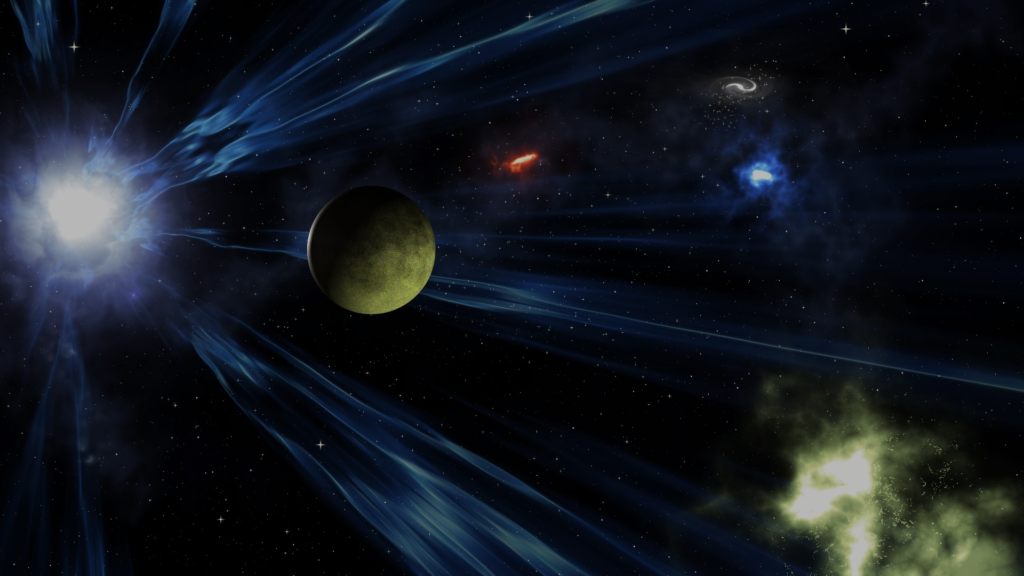## Unraveling the Mysteries of Black Holes: Cosmic Vacuum Cleaners
Have you ever imagined a place where gravity is so strong that not even light can escape? That’s the mind-bending reality of a black hole – a region of spacetime with gravity so intense it creates a singularity, a point of infinite density. These cosmic behemoths aren’t just science fiction; they’re real, and their existence challenges our understanding of the universe. Let’s dive into the fascinating world of black holes!
**1. From Stellar Giants to Gravitational Graveyards: The Formation of Black Holes**
Most black holes form from the death of massive stars. Imagine a star many times larger than our Sun, burning fiercely through its nuclear fuel. When this fuel runs out, the star can’t support its own immense weight. Gravity takes over, causing a catastrophic collapse. If the star’s core is massive enough (generally more than three times the mass of our Sun), the collapse continues relentlessly, crushing all matter into an incredibly small space – a black hole. Think of it like squeezing a giant beach ball into the size of a marble! This process is incredibly violent, often resulting in a supernova explosion – one of the most energetic events in the universe.
**2. Anatomy of a Black Hole: Event Horizon and Singularity**
Black holes are characterized by two key features: the event horizon and the singularity. The event horizon is the point of no return. Once something crosses this boundary – whether it’s a star, gas cloud, or even light – it’s forever trapped by the black hole’s gravity. It’s like falling over the edge of a waterfall; there’s no turning back! At the center lies the singularity, a point of infinite density where all the matter of the collapsed star is concentrated. Our current understanding of physics breaks down at the singularity, making it one of the biggest unsolved mysteries in science.
**3. Observing the Unobservable: How We Detect Black Holes**
Since black holes don’t emit light, you might think they’re impossible to detect. But their powerful gravity affects their surroundings in observable ways. Astronomers can detect black holes by observing the effects of their gravity on nearby stars and gas. For instance, if a star orbits an invisible object at incredibly high speeds, it’s a strong indication of a black hole’s presence. Another method is by detecting X-rays emitted by superheated gas swirling around a black hole as it’s pulled in – a process called accretion. These observations provide indirect evidence of black holes’ existence.
**4. Supermassive Black Holes: Galactic Titans**
While stellar-mass black holes form from the collapse of individual stars, supermassive black holes are absolute giants, millions or even billions of times more massive than our Sun. These behemoths reside at the centers of most galaxies, including our own Milky Way. How they formed remains a mystery, but theories suggest they may have grown from smaller black holes merging over billions of years or formed directly from massive gas clouds in the early universe. Their gravity plays a crucial role in shaping the structure and evolution of their host galaxies.
**5. Black Holes: Not Just Destroyers, but Creators?**
While black holes are often portrayed as cosmic destroyers, they also play a significant role in the creation and evolution of galaxies. The energy released during accretion can power jets of particles that travel vast distances, influencing the formation of stars and potentially even seeding galaxies with heavy elements. The intricate relationship between black holes and their environment is a vibrant area of ongoing research.
**Conclusion: A Universe of Wonder**
Black holes, despite their seemingly destructive nature, are fascinating celestial objects that challenge our understanding of gravity, spacetime, and the universe itself. From their formation to their influence on galactic evolution, black holes offer a glimpse into the extreme physics of the cosmos. There’s still so much to learn about these enigmatic objects, so keep exploring, keep questioning, and maybe one day, you’ll contribute to unraveling their mysteries! Share your thoughts and questions in the comments below. And for further exploration, check out resources like NASA’s website and the Chandra X-ray Observatory!


